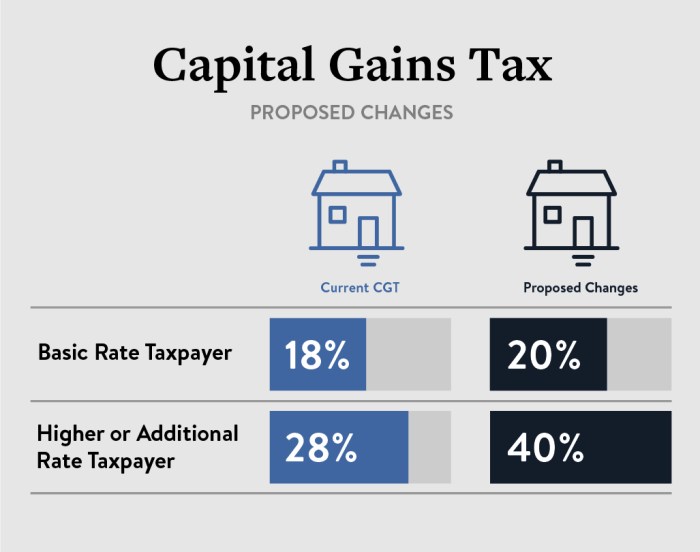Get ready to dive into the realm of capital gains tax, where financial jargon meets real-world implications. From assets to tax rates, we’re breaking it down in a way that’s as cool as your favorite playlist.
Ready to explore the ins and outs of calculating, rates, and strategies? Let’s roll up our sleeves and uncover the secrets of capital gains tax.
What is Capital Gains Tax?
Capital gains tax is a tax imposed on the profit realized from the sale of a capital asset. This tax is applied to the difference between the sale price of the asset and its original purchase price.
Assets Subject to Capital Gains Tax
- Stocks and bonds
- Real estate properties
- Artwork and collectibles
- Businesses
These are just a few examples of assets that are subject to capital gains tax. When these assets are sold for a profit, the tax is levied on the gain made from the sale.
Difference from Other Taxes
- Income Tax: Capital gains tax is different from income tax, as income tax is levied on the earnings from work or investments, while capital gains tax is specifically on the profit from the sale of assets.
- Property Tax: Property tax is a tax on the value of real estate properties owned, while capital gains tax is only triggered when the property is sold for a profit.
- Sales Tax: Sales tax is applied to the purchase of goods and services, whereas capital gains tax is on the gains made from selling assets.
Calculating Capital Gains Tax
When it comes to calculating capital gains tax, there are specific factors to consider that can impact the final amount owed to the government. Understanding the formula, the holding period of an asset, and any deductions or exemptions available is crucial for accurate tax planning.
Formula for Calculating Capital Gains Tax
Capital Gains Tax = (Selling Price – Purchase Price) x Capital Gains Tax Rate
The basic formula for calculating capital gains tax involves subtracting the purchase price of an asset from the selling price to determine the capital gain. This amount is then multiplied by the applicable capital gains tax rate to calculate the tax liability.
Holding Period and Its Impact
The holding period of an asset refers to the length of time an individual holds onto that asset before selling it. In the United States, assets held for more than one year are considered long-term investments, while those held for one year or less are classified as short-term investments. The holding period plays a significant role in determining the tax rate applied to capital gains. Generally, long-term capital gains are taxed at a lower rate than short-term gains, incentivizing investors to hold onto their assets for longer periods.
Deductions and Exemptions
When calculating capital gains tax, there are certain deductions and exemptions that taxpayers may qualify for, reducing the overall tax burden. Some examples include deductions for investment expenses, capital losses, and exemptions for certain types of assets like primary residences. It’s essential for individuals to explore these options to minimize their tax liabilities legally.
Capital Gains Tax Rates
When it comes to capital gains tax rates, it’s important to understand how they vary based on income levels and the type of investment. Long-term and short-term gains are taxed differently, and there are distinctions between rates for individuals and corporations.
Individual Capital Gains Tax Rates
Individuals are subject to different tax rates depending on their income level. Here’s a breakdown:
- For individuals in the lowest tax bracket (10-15%), the long-term capital gains tax rate is 0%.
- For individuals in the middle tax brackets (25-35%), the long-term capital gains tax rate is 15%.
- For individuals in the highest tax bracket (39.6%), the long-term capital gains tax rate is 20%.
It’s important to note that short-term capital gains are taxed at the individual’s ordinary income tax rate, which can be significantly higher than long-term rates.
Corporate Capital Gains Tax Rates
Corporations have a flat capital gains tax rate of 21% regardless of income level. This rate applies to both long-term and short-term capital gains earned by corporations.
Unlike individuals, corporations do not benefit from lower long-term capital gains tax rates, as they are subject to a single rate.
Strategies to Minimize Capital Gains Tax

When it comes to reducing your capital gains tax liabilities, there are several strategies you can consider. These strategies can help you optimize your tax situation and potentially save you money in the long run.
Tax-Loss Harvesting
Tax-loss harvesting is a strategy where you sell investments that have experienced a loss to offset capital gains. By strategically selling investments at a loss, you can reduce your overall capital gains tax liability. This technique allows you to use your investment losses to your advantage when it comes to tax time.
Deferring Capital Gains
Another way to minimize capital gains tax is by deferring the realization of capital gains. Instead of selling an investment that has appreciated in value, you can hold onto it for a longer period of time. By delaying the sale, you can postpone paying taxes on the capital gains until a later date, potentially when you are in a lower tax bracket.
Capital Gains Tax Exemptions or Deductions
You can also take advantage of various exemptions and deductions to reduce your capital gains tax burden. For example, if you meet certain requirements, you may be eligible for a tax exemption on the sale of your primary residence. Additionally, you can deduct certain expenses related to your investments, such as brokerage fees or investment advisory fees, from your capital gains.
